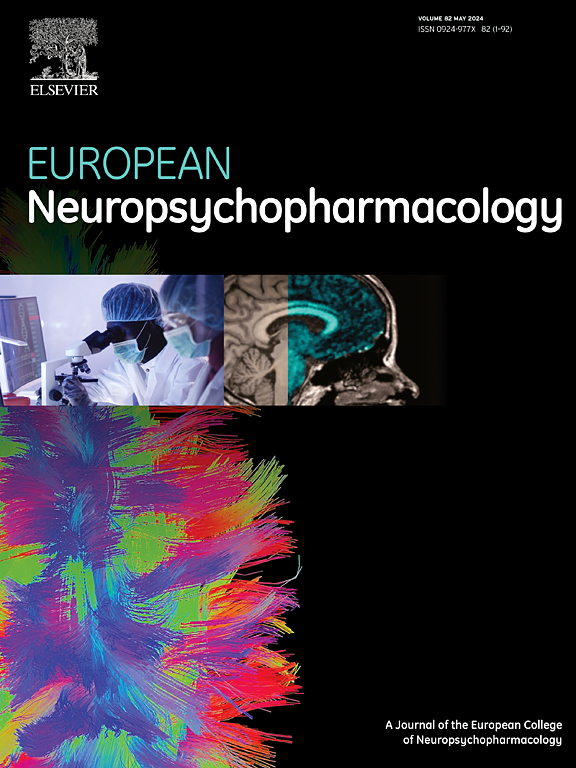性别在性别偏倚性脑部疾病多基因风险中的作用
IF 6.7
2区 医学
Q1 CLINICAL NEUROLOGY
引用次数: 0
摘要
遗传易感性的性别差异与精神和神经退行性疾病有关,但它们对大脑健康和临床风险的具体影响仍知之甚少。利用来自英国生物银行(UK Biobank)的多达220,836名女性和187,651名男性(39-81岁)的数据,我们评估了重度抑郁症(PRSMDD)、阿尔茨海默病(PRSAD)、精神分裂症(PRSSCZ)和帕金森病(PRSPD)的性别和多基因风险评分(PRSs)与病例对照状态和脑年龄差距(BAG)(脑健康的神经影像学标志物)的关系。我们测试了PRSs的性别差异,并进行了回归分析,检验了性别、PRSs和病例对照状态或BAG之间的关系。然后,我们比较了性别池和性别特异性PRSs模型,以探索性别特异性PRSs是否可以提高预测准确性。虽然女性的PRSSCZ高于男性,但在prsz之间没有发现其他性别差异。我们最引人注目的发现是PRSAD与性别的显著相互作用,其中PRSAD赋予女性比男性更大的AD诊断风险。一致地,仅限女性的PRSAD模型优于性别混合模型,而性别混合模型和仅限男性的模型之间没有差异。相比之下,性别混合的PRS模型在MDD、SCZ和PD方面的表现优于性别特异性的PRS模型。无性别- prs交互作用与BAG显著相关。然而,男性的BAG值高于女性,表明大脑年龄较大。此外,不论性别,较高的PRSMDD、较高的PRSAD和较低的PRSPD均与较高的BAG相关。最后,BAG模型的性能在性别池和性别特定的PRS模型之间没有差异。我们的研究结果强调,在中老年成年人中,性别调节AD诊断状态的遗传风险,因此,按性别定制PRSs可能会改善AD的风险评估。虽然性别特异性PRSs对其他疾病的价值有限,但我们的研究结果表明,性别特异性PRSs的价值可能会随着统计能力的提高而增加。本文章由计算机程序翻译,如有差异,请以英文原文为准。
THE ROLE OF SEX IN POLYGENIC RISK FOR SEX-BIASED BRAIN DISORDERS
Sex differences in genetic vulnerability have been implicated in psychiatric and neurodegenerative disorders, yet their specific impact on brain health and clinical risk remains poorly understood. Leveraging data from up to 220,836 women and 187,651 men from the UK Biobank (aged 39–81), we assessed how sex and polygenic risk scores (PRSs) for major depressive disorder (PRSMDD), Alzheimer’s disease (PRSAD), schizophrenia (PRSSCZ), and Parkinson’s disease (PRSPD) relate to case-control status and brain age gap (BAG), a neuroimaging marker of brain health. We tested for sex differences in PRSs and performed regression analyses examining associations between sex, PRSs, and either case-control status or BAG. We then compared models with sex-pooled and sex-specific PRSs to explore whether sex-specific PRSs can improve predictive accuracy. While PRSSCZ was higher in women compared to men, no other sex differences were found between PRSs. Our most striking finding was a significant PRSAD-by-sex interaction, in which PRSAD conferred greater risk for AD diagnosis in women compared to men. Consistently, the women-only PRSAD model outperformed the sex-pooled model, while no differences were observed between sex-pooled and men-only models. By contrast, sex-pooled PRS models outperformed sex-specific PRS models for MDD, SCZ, and PD. No sex-by-PRS interactions were significantly associated with BAG. However, men presented with higher BAG values than women, indicative of an older brain age. Further, higher PRSMDD, higher PRSAD, and lower PRSPD were each associated with higher BAG, irrespective of sex. Finally, BAG model performance did not differ between sex-pooled and sex-specific PRS models. Our findings highlight that sex moderates AD genetic risk for diagnostic status in middle-to-late-life adults, and as such, tailoring PRSs by sex may improve risk assessment for AD. While sex-specific PRSs offered limited value for the other disorders, our findings suggest that the value of sex-specific PRSs will likely grow with increased statistical power.
求助全文
通过发布文献求助,成功后即可免费获取论文全文。
去求助
来源期刊

European Neuropsychopharmacology
医学-精神病学
CiteScore
10.30
自引率
5.40%
发文量
730
审稿时长
41 days
期刊介绍:
European Neuropsychopharmacology is the official publication of the European College of Neuropsychopharmacology (ECNP). In accordance with the mission of the College, the journal focuses on clinical and basic science contributions that advance our understanding of brain function and human behaviour and enable translation into improved treatments and enhanced public health impact in psychiatry. Recent years have been characterized by exciting advances in basic knowledge and available experimental techniques in neuroscience and genomics. However, clinical translation of these findings has not been as rapid. The journal aims to narrow this gap by promoting findings that are expected to have a major impact on both our understanding of the biological bases of mental disorders and the development and improvement of treatments, ideally paving the way for prevention and recovery.
 求助内容:
求助内容: 应助结果提醒方式:
应助结果提醒方式:


